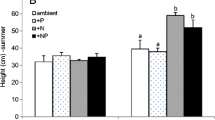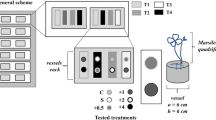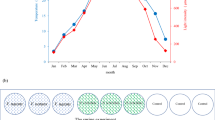Abstract
The series of reservoirs located in the upper Paraná River and its tributaries retain a large amount of phosphorus (sedimentation), impoverishing downstream waters. Although these nutrients are limiting for primary production, their role on the growth of native aquatic plants is still unknown. The free-floating macrophyte, Eichhornia crassipes, is among the most successful colonizers and fastest-growing macrophytes in the Neotropics. However, in the upper Paraná River floodplain, this plant rarely develops extensive coverage and it is even absent from some environments. We hypothesize that phosphorus concentration is limiting the growth of E. crassipes in certain aquatic habitats of this floodplain, and to test this hypothesis we designed a field mesocosm experiment using nutrient amendments. Twelve closed mesocosms (1,500 L) plus three open units (with ambient lagoon water) were set up in the Garças lagoon, under five nutrient treatments (three replicates each): L (“lagoon”, no addition), C (control, no addition), +N (nitrogen addition), +P (phosphorus addition), and +NP (nitrogen and phosphorus addition). After nutrient amendments, introduced plants were weighed weekly for fresh biomass over a three-week period. Plants in the +P and +NP treatments had the most rapid increase in biomass (rmANOVA, F12,30 = 7.54, p < 0.05) and the greatest development of sprouts (F12,30 = 3.25, p < 0.05). In addition, phosphorus content in plant tissues was highest in +P and +NP treatments, while nitrogen content was similar in L, +N, and +NP treatments. Our results suggest that the growth of water hyacinth in the upper Paraná River floodplain is limited by phosphorus, not nitrogen. Phosphorus removal in upstream reservoirs may limit E. crassipes populations downstream, although more study is required to establish this link.
Similar content being viewed by others
Literature Cited
Agostinho, A. A., L. C. Gomes, S. Veríssimo, and E. K. Okada. 2004. Flood regime, dam regulation and fish in the upper Paraná River: effects on assemblage attributes, reproduction and recruitment. Reviews in Fish Biology and Fisheries 14: 11–19.
Agostinho, A. A., A. E. A. M. Vazzoler, and S. M. Thomaz. 1995. The high river Paraná basin: limnological and icthyological aspects. p. 59–103. In J. G. Tundisi, C. E. M. Bicudo, and T. Matsumura-Tundisi (eds.) Limnology in Brazil. Brazilian Academy of Sciences. Brazilian Limnological Society, São Paulo, Brazil.
Agostinho, A. A. and M. Zalewski. 1995. The dependence of fish community structure and dynamics on floodplain and riparian ecotone zone in Paraná River, Brazil. Hydrobiologia 303: 141–48.
Barbosa, F. A. R., J. Padisák, E. L. G. Espíndola, G. Borics, and O. Rocha. 1999. The cascading reservoir continuum concept (CRCC) and its application to the river Tietê-basin, São Paulo State, Brazil. p. 425–37. In J. G. Tundisi and M. Straškraba (eds.) Theoretical Reservoir Ecology and Its Applications. International Institute of Ecology, Brazilian Academy of Sciences and Backhuys Publishers, Leiden, The Netherlands.
Bini, L. M., S. M. Thomaz, and D. C. Souza. 2001. Species richness and diversity of aquatic macrophytes in the upper Paraná River floodplain. Archiv für Hydrobiologie 151: 511–25.
Bock, J. H. 1969. Productivity of the water hyacinth Eichhornia cvassipes (Mart.) Solms. Ecology 50: 460–64.
Camargo, A. F. M., M. M. Pezzato, and G. G. Henry-Silva. 2003. Fatores limitantes à produção primária de macrófitas aquáticas. p. 59–83. In S. M. Thomaz and L. M. Bini (eds.) Ecologia e Manejo de Macrófitas Aquáticas. Eduem, Maringá, Brasil.
Carignan, R. and J. J. Neiff. 1992. Nutrient dynamics in the floodplain ponds of the Paraná River (Argentina) dominated by the water hyacinth Eichhornia cvassipes. Biogeochemistry 17: 85–121.
Carignan, R., J. J. Neiff, and D. Planas. 1994. Limitation of water hyacinth by nitrogen in subtropical lakes of the Paraná floodplain (Argentina). Limnology and Oceanography 39: 439–43.
Carignan, R. and D. Planas. 1994. Recognition of the nutrient and light limitation in turbid mixed layers: three approaches compared in the Paraná Floodplain (Argentina). Limnology and Oceanography 39: 580–96.
Carvalho, P., L. M. Bini, S. M. Thomaz, L. G. Oliveira, B. Robertson, W. L. G. Tavechio, and A. J. Darwisch. 2001. Comparative limnology of South America floodplain lakes and lagoons. Acta Scientiarum 23: 265–73.
Chapin, C. T., S. D. Bridgham, and J. Pastor. 2004. pH and nutrient effects on above-ground net primary production in a Minnesota, USA bog and fen. Wetlands 24: 186–201.
Cook, C. D. K. 1990. Origin, autoecology and spread of some of the world’s most troublesome aquatic weeds. p. 31–38. In A. H. Pieterse and K. J. Murphy (eds.) Aquatic Weeds: The Ecology and Management of Nuisance Aquatic Vegetation. Oxford University Press, New York, NY, USA.
Esteves, F. A. 1982. Biomass and analysis of the major inorganic components of floating aquatic macrophytes (Eichhornia cvassipes (Mart.) Solms) in six reservoirs of São Paulo State (Brazil). Ciência e Cultura 34: 1196–1200.
Esteves, F. A. 1988. Fundamentos de Limnologia. Interciência/ FINEP, Rio de Janeiro, Brasil.
Gopal, B. 1987. Water Hyacinth: Aquatic Plant Studies. Elsevier Science Publishers, The Netherlands.
Henry, R., A. A. N. Santos, and Y. R. Camargo. 1999. Transporte de sólidos suspensos, N e P total pelos rios Paranapanema e Taquari e uma avaliação de sua exportação na represa de Jurumirim (São Paulo, Brasil). p. 687–710. In R. Henry (ed.) Ecologia de Reservatórios: Estrutura, Função e Aspectos Sociais. FAPESP-FUNDIBIO, Botucatu, Brasil.
Huszar, V. L. M., N. F. Caraco, F. Roland, and J. Cole. 2006. Nutrient-chlorophyll relationships in tropical-subtropical lakes: do temperate models fit? Biogeochemistry 79: 239–50.
Imaoka, T. and S. Teranishi. 1988. Rates of nutrient uptake and growth of the water hyacinth [Eichhornia crassipes (Mart.) Solms]. Water Research 22: 943–51.
Junk, W. J., P. B. Bayley, and R. E. Sparks. 1989. The flood pulse concept in river floodplain systems. p. 110–27. In D. P. Dodge (ed.) Proceedings of the International Large River Symposium (LARS). Department of Fisheries and Oceans, Ottawa, Canada (Canadian Special Publication in Fisheries and Aquatic Sciences 106).
Lorenzi, H. 2000. Plantas daninhas do Brasil: terrestres, aquáticas, parasitas e tóxicas. Instituto Plantarum de Estudos da Flora Ltda, São Paulo, Brasil.
Mackereth, F. Y. H., J. G. Heron, and J. F. Tailing. 1978. Water Analysis: Some Revised Methods for Limnologists. Freshwater Biological Association. Scientific Publication, Titus Wilson & Son Ltd, Kendall, UK.
Marcondes, D. A. S., A. L. Mustafá, and R. H. Tanaka. 2003. Estudos para manejo integrado de plantas aquáticas no reservatório de Jupiá. p. 299–317. In S. M. Thomaz and L. M. Bini (eds.) Ecologia e Manejo de Macrófitas Aquáticas. Eduem, Maringá, Brasil.
Martins, D., N. V. Costa, M. A. Terra, S. R. Marchi, and E. D. Velini. 2003. Caracterização química das plantas aquáticas coletadas no reservatório de Salto Grande (Americana — SP). Planta Daninha 21: 21–25.
Murphy, K. J., G. Dickinson, S. M. Thomaz, L. M. Bini, K. Dick, K. Greaves, M. P. Kennedy, S. Livingstone, H. McFerran, J. M. Milne, J. Oldroyd, and R. A. Wingfield. 2003. Aquatic plant communities and predictors of diversity in a sub-tropical river floodplain: the upper Rio Paraná, Brazil. Aquatic Botany 77: 257–76.
Neiff, J. J., A. Poi De Neiff, and S. A. L. Casco. 2001. The effect of prolonged floods on Eichhornia crassipes growth in Paraná River floodplain lakes. Acta Limnologica Brasiliensia 3: 51–60.
Poi de Neiff, A., J. J. Neiff, O. Orfeo, and R. Carignan. 1994. Quantitative importance of particulate matter retention by the roots of Eichhornia crassipes in the Paraná floodplain. Aquatic Botany 47: 213–23.
Reddy, K. R. and E. M. D’Angelo. 1990. Biomass yield and nutrient removal by water hyacinth (Eichhornia crassipes) as influenced by harvesting frequency. Biomass 21: 27–42.
Rocha, R. R. A. and S. M. Thomaz. 2004. Temporal variation of limnological factors in the upper Paraná River floodplain habitats. Acta Scientiarum 26: 261–71.
Sculthorpe, C. D. 1985. The Biology of Aquatic Vascular Plants. Edward Arnold, London, UK.
Souza, D. C., S. M. Thomaz, and L. M. Bini. 2002. Species richness and beta diversity of aquatic macrophytes in three floodplain tropical lagoons evaluating the effects of sampling size and depth gradients. Amazoniana — Limnologia Et Oecologia Regionalis Systemae Fluminis Amazonas 17: 213–25.
Spencer, W. and G. Bowes. 1990. Ecophysiology of the world’s troublesome aquatic weeds. p. 39–73. In A. H. Pieterse and K. J. Murphy (eds.) Aquatic Weeds: The Ecology and Management of Nuisance Aquatic Vegetation. Oxford University Press, New York, NY, USA.
Statsoft, Inc. 2005. Statistica (data analysis software system). Version 7.1. Tulsa, OK, USA.
Thomaz, S. M., T. A. Pagioro, L. M. Bini, M. C. Roberto, and R. R. A. Rocha. 2004. Limnology of the upper Paraná floodplain habitats: patterns of spatio-temporal variations and influence of the water levels. p. 37–42. In A. A. Agostinho, L. Rodrigues, L. C. Gomes, S. M. Thomaz, and L. E. Miranda (eds.) Structure and Functioning of the Paraná River and its Floodplain (Peld-site6). Eduem, Maringá, Brasil.
Tundisi, J. G. and T. Matsumura-Tundisi. 2003. Integration of research and management in optimizing multiples uses of reservoirs: the experience in South America and Brazilian case studies. Hydrobiologia 500: 231–42.
Xie, Y., M. Wen, D. Yu, and Y. Li. 2004. Growth and resource allocation of water hyacinth as affected by gradually increasing nutrient concentrations. Aquatic Botany 79: 257–66.
Xie, Y. and D. Yu. 2003. The significance of lateral roots in phosphorus (P) acquisition of water hyacinth (Eichhornia crassipes). Aquatic Botany 75: 311–21.
Zagatto, E. A. G., A. O. Jacintho, B. F. Reis, F. J. Krug, H. Bergamin, L. C. R. Passenda, J. Mortatti, and M. F. Giné. 1981. Manual de Análises de Plantas Empregando Sistemas de Injeção em Fluxo. Universidade de São Paulo, Piracicaba, Brasil.
Author information
Authors and Affiliations
Rights and permissions
About this article
Cite this article
Kobayashi, J.T., Thomaz, S.M. & Pelicice, F.M. Phosphorus as a limiting factor for Eichhornia crassipes growth in the upper Paraná River floodplain. Wetlands 28, 905–913 (2008). https://doi.org/10.1672/07-89.1
Received:
Accepted:
Issue Date:
DOI: https://doi.org/10.1672/07-89.1




